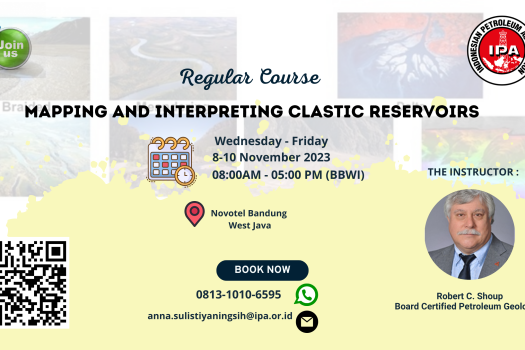IPA Course : Mapping and Interpreting Clastic Reservoirs
|
This exercise-driven class will help interpreters characterize clastic reservoirs and to delineate reservoir facies in clastic depositional systems. |
Course Description and Objectives
Our ability to predict reservoir presence or map net reservoir in clastic depositional systems is dependent on our understanding of the depositional geometries of the various depositional systems and the variation of patterns within those systems. The processes associated with sediment delivery and sediment dispersal is the fundamental control on the architectural geometry of a depositional system. The processes associated with the interplay between sediment input and accommodation space are the fundamental controls on the lateral and vertical stacking patterns within that geometry.
The geometry of the depositional system is similar regardless of the depositional location or scale. As such, the patterns within the geometries are also similar, and, therefore, predictable. This is a powerful concept that the interpreter can use in predicting depositional geometries and patterns. Whether the reservoir being studied was deposited on land or on a submarine fan, or whether it is 100’s of kilometers in scale or a kilometer, the geometry of the deposit is similar. Therefore, interpreters need only become familiar with the basic geometries of clastic depositional systems and the patterns that occur within those geometries.
Modern and outcrop analogs will be used, along with subsurface examples to provide the interpreter with a sound understanding of the reservoir distribution and quality, both laterally and vertically of the clastic depositional systems most commonly encountered as oil and gas reservoirs. The course is exercise-oriented and taught in PowerPoint format. A course manual is provided. The exercises in this course are designed to give you a strong working knowledge of the many depositional settings you are likely to encounter in your career. They are aimed at helping you to learn how to recognize them from well logs, and how to map them.
Learning Outcomes:
- Understand the basics of correlating well logs in clastic sequences utilizing shale and resistivity markers, interval thickness, sequence stacking patterns and cross-sections
- Review the fundamental controls that influence clastic depositional systems
- Understanding of the lateral and vertical reservoir distribution, reservoir characteristics and connectivity of braided, meandering, anastomosing, and entrenched river systems
- Understanding of the lateral and vertical reservoir distribution, reservoir characteristics and connectivity of alluvial fans, deltas, and submarine fan systems
- Improved ability to construct accurate sand percent maps for reservoir prediction, and net sand and net pay isochore maps for accurate reservoir characterization.
- Learn how to read a core and interpret the depositional environment

About the Instructor
 |
Robert ‘Bob’ Shoup is a Board Certified Petroleum Geologist with over 38 years of experience in basin analysis, regional studies, new play generation, prospect evaluation, field studies, and project management. Bob began his career at Shell Oil in 1980; followed by four years working for private oil companies before becoming an independent consultant in 2003. Bob teaches various Subsurface Consultants & Associates (SCA) training courses areas around the world and currently serves as SCA’s Chief Geologist. Bon is also the Director of Clastic Reservoir Systems. Throughout his career he has discovered or helped to discover over 135 MMBOE.
Bob is a recognized expert in clastic depositional environments and syndepositional structural systems. Bob is an active contributor to the professional community. He is a Past President of Bangkok SEAPEX and AAPG’s Division of Professional Affairs and past Secretary-Editor and Chair of the AAPG House of Delegates. He has served on numerous AAPG Committees and was Chairman of AAPG's Mentor, Membership and Student Chapter Committees. He is a recipient of eight AAPG Certificates of Merit; AAPG’s Distinguished Service Award in 2000, and the DPA’s Distinguished Service Award in 2008 and made Life Member of the DPA in 2010. Bob is also a life member of the IPA, the Geological Society of Malaysia, and the South East Asia Exploration Society How to register:
|


